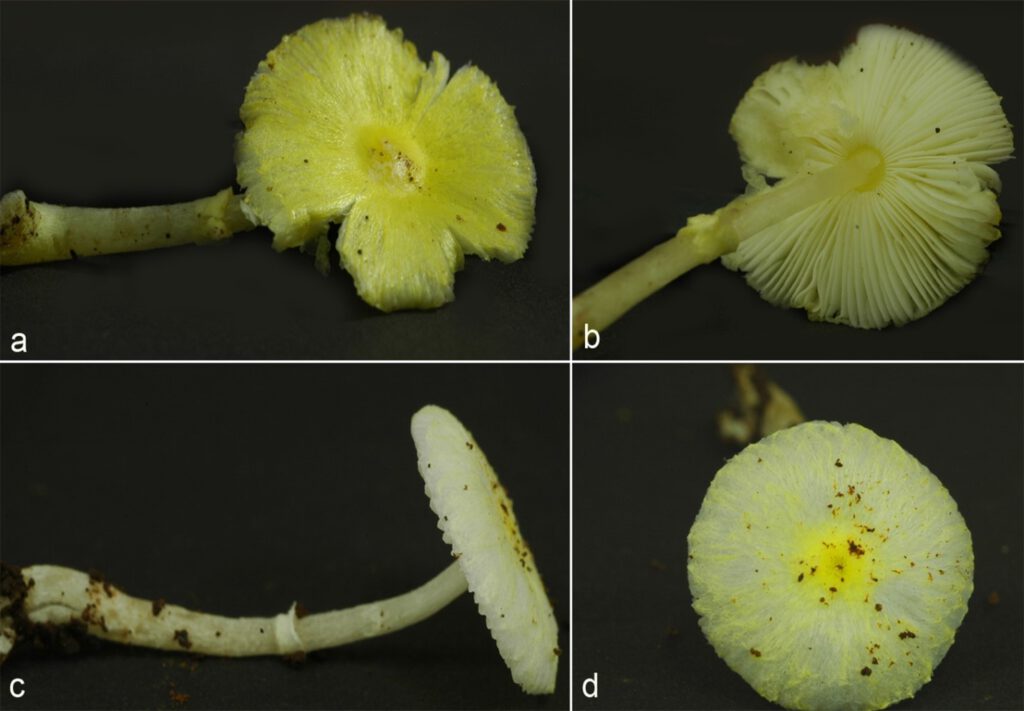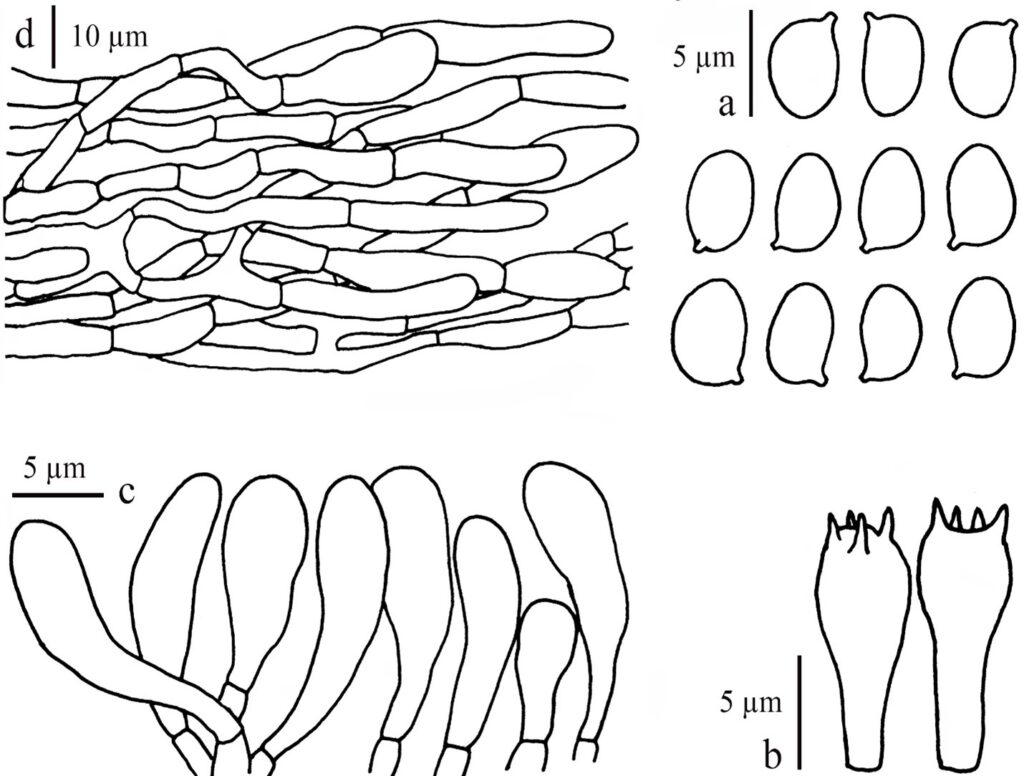Leucoagaricus flavus
MycoBank number: MB 559485; IndexFungorum number: IF 559485; Facesoffungi number: FoF 10799;
Description
Pileus 15–20 mm diam., umbonate, expanding applanate with low umbo, with straight margin; smooth and pale yellow to pastel yellow (3A3–4) at the umbo, breaking around umbo and with concentrically concolorous fibrillose toward the margin, sometimes peeling and with white to the pale yellow fibrillose background; marginal zone fibrillose, concolorous with dish, sulcate and fringed when mature. Lamellae free, pale yellow to pastel yellow (3A3), ventricose, up to 1.5 mm wide, slightly crowded, with 3lamellulae, with a concolorous eroded edge. Stipe 30–35 × 3–5 mm, cylindrical or slightly tapering to apex, with wide base; covered with white to yellowish-white (4A2) fibrillose or soft hair, on yellowish-white (2A2) background. Annulus cuff-liked, fibrillose, concolorous with pileus covering, attached at the middle zone of the stipe. Context in pileus white, thin, up to 2 mm wide; in stipe hollow, concolorous with surface, hollow and with white fibrils in hollow. Smells distinct, soft, flower, fleshy. Taste not observed. Spore print white.
Basidiospores [50,2,2] l × w= 4.8–5.3 × 3.5–4 µm, avl × avw= 5.0 × 3.8 µm, Q= 1.2–1.4, Qav= 1.3, in side-view broadly ellipsoidal ovoid to ellipsoidal ovoid, in frontal view ovoid to ellipsoid, slightly thick-walled, hyaline, without a germ pore, dextrinoid, congophilous, cyanophilous, metachromatic. Basidia 13.0–16 × 6.0–7.5 µm, clavate, hyaline, thin-walled, 4-spored. Pleulocustidia absent. Cheilocystidia 14–42 × 5–10 µm, clavate to narrowly clavate, hyaline, thin-walled. Pileus covering a cutis made up of cylindrical elements, sometimes with narrowly clavate, 15–41 × 3–7 µm, thin-walled, hyaline to pale yellow, with cylindrical and concolorous hyphae, 3–5 µm wide. Stipe covering same as pileus covering, a cutis made up of cylindrical and hyaline elements, 10–35 × 3–5 µm µm wide, thin-walled, with hyaline hyphae, 2–3.5 µm wide, thin-walled. Clamp connections are absent in all tissues.
Habitat and known distribution – growing solitary, saprotrophic, on humus soil; two samples were found in deciduous and bamboo forests during the the rainy season (October to November 2015) of central Laos.
Material examined – Laos, Bolikhamxay Province, Thaphabath District, Tad Xay Waterfall, 14 Oct 2015, P. Sysouphanthong, PS148 (HNL503375, holotype); Vientiane Capital, Xaythany District, Houay Nhang Preserve Forest, 17 Nov 2015, P. Sysouphanthong, PS201 (HNL503428, paratype).
GenBank numbers: ITS: MZ577102, MZ577103 (ITS1-F/ITS4).
Discussions – Leucoagaricus flavus has pale yellow to pastel yellow basidiomata, free and pale yellow to pastel lamellae, white to yellowish-white stipe, cuff-liked annulus, ovoid basidiospore, clavate to narrowly clavate cheilocystidia and a cutis pileus- and stipe covering. These characters distinctly distinguish the species from other characters. However, there are some species with yellow to yellowish green color that might be confused with Leucoagaricus flavus.
Leucoagaricus orientiflavus Z.W. Ge is most similar to Leucoagaricus flavus by pastel yellow, light yellow, yellow or yellowish white fibrillose pileus; yellowish to yellowish white stipe surface; white to yellowish white annulus; amygdaliform basidiospores; clavate to narrowly clavate cheilocystidia and a cutis pileus- and stipe covering. However, Leucoagaricus orientiflavus is different from Leucoagaricus flavus on larger basidiomata (30–80 mm diam. of pileus), larger basidiospore (6.0–7.5 × 3.0–4.0 μm) and larger basidia (17–24 × 6–7.5 μm) (Ge 2010).
Leucoagaricus houaynhangensis is different in yellowish-green basidiomata with dark grey to black squamules on pileus and with appendiculate margin, basidiospores with a germ pore, and a trichodarm pileus covering (Sysouphanthong et al. 2018).
Other species with yellowish-green basidiomata, Leucoagaricus sulphurellus (Pegler) B.P. Akers and Leucoagaricus viridiflavoides B.P. Akers & Angels (Akers et al. 2000), but they are different on having brown to greyish-brown pileus covering, presence of pleurocystidia and bruising blue when touched.
Furthermore, Leucoagaricus viridiflavus differs from Leucoagaricus flavus in having the darker colour of basidiomata (olive green) and bruising blue, basidiospore with a germ pore, utriform cheilocystidia with short to long appendages (Kumar & Manimohan 2009).
Some species of genus Leucocoprinus with yellow basidiomacota are Leucocoprinus birnbaumii (Corda) Singer, Leucocoprinus flavescens (Morgan) H.V. Sm., Leucocoprinus flavus (Beeli) Heinem., Leucocoprinus flos-sulphuris (Schnizl.) Cejp and Leucocoprinus fragilissimus (Ravenel ex Berk. & M.A. Curtis) Pat. All of them have distinctly long striate on pileus, while it is absent in Leucoagaricus flavus.

Fig. 1 – Fresh basidiomata of Leucoagaricus flavus in situ. a–b (HNL503375, holotype), c–d (HNL503428)

Fig. 2 – Microcharacteristics of Leucoagaricus flavus (HNL503375, holotype). a= basidiospores, b= basidia, c. cheilocystidia, d. pileus covering.
